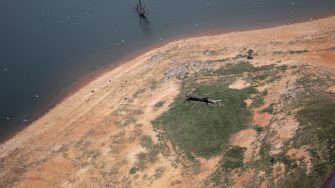
Date: Tuesday, November 10, 2015
Project: Eastern Australian Waterbird Survey
Observer: Richard Kingsford
Long day today – about seven hours of flying across the southern part of the Murray-Darling Basin. We set off west of Swan Hill out to Lake Tyrell which is a large salt lake, only occasionally with water. The dry salt makes wonderful patterns on the dry lake bed.
Lake Tyrell in Victoria was dry
We prepare for finding which lakes are dry and which have water by inspecting satellite imagery before surveys. There was a slight hint of water on the southern part of Lake Hindmarsh, further west of Lake Tyrell. We knew from the imagery that the Ramsar listed Lake Albacutya was dry but a little bit of flooding can support large numbers of waterbirds, demanding a survey. When we arrived at Lake Hindmarsh – it was disappointing with just a few Australian shelduck on the creek running into the lake.
From there back across to the Kerang Lakes. Lake Bael Bael, the Marsh and Koorangie Game Reserve were dry; during wet periods these lakes have thousands of waterbirds. We started at the most southwesterly lake – Lake Elizabeth. It had hundreds of waterbirds.
Lake Elizabeth, one of the small slightly salty of the Kerang Lakes.
Many of the lakes were dry, particularly the salt lakes.
A dry salt lake among the Kerang Lakes
The great surprise was the size of the colony of straw-necked ibis on one of the Kerang Lakes. Ibis regularly breed on these lakes and I had expected perhaps a few white ibis nests. They are the generalists and can nearly always breed in small numbers. I had not expected the 5-10,000 straw-necked ibis breeding, particularly in such a dry year. It begs the question about triggers for breeding and also where they are obtaining sufficient food for their chicks.
Breeding colony of straw-necked ibis on the Kerang Lakes
Once we had finished the Kerang Lakes, we headed back east to survey other wetlands in the Riverina, including Tom Bullen Reservoir near Narrandera. This permanently filled wetland supported only a handful of mostly fish-eating waterbirds.
On our way south, we had expected Lake Urana to be dry. This large lake was drying back last year but it had a small amount of water in the southern end. And this shallow water was extremely productive for waterbirds with thousands of waterbirds, including mostly grey teal, glossy ibis, red-necked avocets, yellow-billed spoonbills and pink-eared ducks.
Surveying the drying Lake Urana with thousands of waterbirds.
We ended by surveying Hume Dam which, with Dartmouth Dam, are the major river regulation structures on the river. The water levels were low compared to previous years. Also like other years the dam supports relatively few waterbirds and mostly only fish eating birds, including pelicans and cormorants. These large dams do not offer productive environments, even in extremely dry years.
Surveying Hume Dam, showing the high water mark of the dam, contrasting the water and its surrounds.
There was a surprise despite the small numbers of waterbirds. Silver gulls had set up a colony on one of the islands of the dam with an estimated 100-200 birds nesting.
Silver gull colony on Hume Dam.
